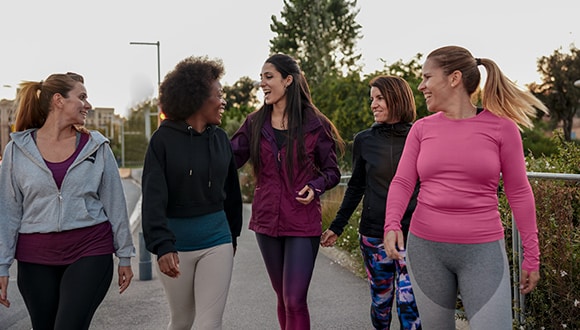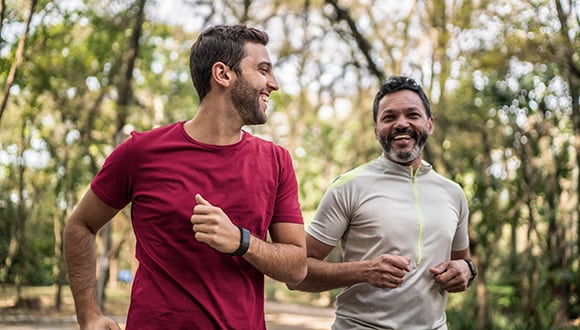Walking vs running: which is better for your health?
Updated June 2024 | 5 min read
Expert contributors Trevor Shilton, Adjunct Professor in the School of Human Sciences at the University of Western Australia; Kate Pumpa, Associate Professor in Exercise Physiology and Sports Nutrition at the University of Canberra
Words by Angela Tufvesson and Stephanie Osfield
If you want to enjoy the health benefits of gym-free cardio exercise, walking and running are both great options, but which is the better workout?
Exercising at a moderate intensity may be one of the keys to getting fitter, but you don’t have to do bootcamp or triathlons to boost your heart rate. Walking and running are both great cardio exercise options.
Both allow you to exercise outdoors in small groups and without equipment, which is one of the safest, most enjoyable ways to stay active. Here’s a roundup of the main benefits of adding either walking or running (or both) to your exercise routine.
Why cardio exercise is good for you
Regardless of your age, weight or sporting prowess, cardio exercise – any continuous exercise that gets your heart rate up and burns more kilojoules – is great for your health and weight loss or weight management.
"Regular cardio exercise has an abundance of benefits," says Trevor Shilton, Adjunct Professor in the School of Human Sciences at the University of Western Australia.
It helps with body fat loss, reduces your risk of chronic conditions like heart disease and type 2 diabetes, helps build strong bones and is linked to improved immunity.
When it comes to mental health, cardio exercise helps you manage stress and improves your mood, thanks to the release of feel-good chemicals in the brain.

Walking vs running
Walking is the most popular form of exercise for Australians, with over half of Aussies over 14 years old regularly heading out for a brisk walk. Running comes in at third place (after going to the gym/weight training), with 2.3 million Aussies now regularly jogging.
But if you’re wondering whether walking or running is the better choice for you, it’s important to understand it’s not an ‘either-or’ situation. Your health would benefit from walking or jogging, or you could mix it up and do both.
"Walking and running are both great choices for improving fitness and health," says Adjunct Prof Shilton. "Walking regularly for 30 to 60 minutes a day can help you enjoy the same health benefits as running. The only drawback is that the pace of walking is slower so it takes a little longer to gain the same benefits.”
Whether you jog or walk, you should aim to meet the Department of Health physical activity and exercise guidelines, which recommend that each week you do 150 to 300 minutes of moderate physical activity like brisk walking, or 75 to 150 minutes of vigorous physical activity like running.
Benefits of walking
Walking is something nearly everyone can do. It’s easy, cost-free and flexible. You can walk at any time of the day, as a dedicated exercise session, or as a more active form of transport, instead of catching the bus or driving to a friend’s house.
Adjunct Prof Shilton says walking is a good exercise option for older adults and people who are overweight or affected by chronic conditions like heart disease and diabetes.
"Because walking is low impact, your joints and bones are only put under minimal stress, so the risk of injury is lower," he explains.
Walking is also a great choice if you’re new to exercising or returning after a break.
"As you ease into walking, you can improve your strength, heart, lung function and energy levels,” says Kate Pumpa, an Associate Professor in Exercise Physiology and Sports Nutrition at the University of Canberra.
“Some people also say that walking improves their memory and helps them think more clearly."
Even just 30 minutes of walking every day can help reduce your risk of disease. Walking also offers benefits, like helping to reduce the incidence of breast cancer and boosting joint health and immunity.

Benefits of running
If you want to improve your fitness and live longer, running is also a great choice.
“You can change intensity from a jog to a sprint or mix up short bursts of fast and slow running as a form of interval training,” Assoc Prof Pumpa says.
“Running raises your heart rate and circulation, so it can be good for your cardiovascular system while increasing your metabolic rate, so you keep burning calories after your workout, even when you’re sitting still.”
Jogging is also ideal for working towards a goal, like training for a 15- or 30-minute run or aiming to beat your personal-best time on a lap of the beach or the oval.
"Many runners enjoy the feeling of achievement during and after a run, which can lead to an ‘endorphin rush’ or ‘runner’s high’ that can really get you hooked,” says Adjunct Prof Shilton.
If you’re new to running, Shilton suggests it can be helpful to start with alternating intervals of running and walking. "In a 30-minute session, you might alternate running for five minutes and walking for five minutes," he adds.
Despite many people thinking it's high impact, running can be good for your knees and joints.
"It’s a myth that putting more pressure on the joints through running always leads to increased wear and tear,” says Assoc Prof Pumpa. In fact, research suggests running may help protect the knees from osteoarthritis and doesn’t increase symptoms or progression of the condition either.
That said, if you’ve experienced a past knee injury or knee surgery, have a higher body mass index (BMI) or you’re in an older age group, then running may not be the best exercise for you, so check with your GP or exercise physiologist for advice first.
If any exercise doesn’t feel right for your body or fitness level, stop and consult a medical professional.
Should you join a walking or running group?
Working out with a buddy or group is a win-win for your exercise routine.
“When exercise is social it often becomes more enjoyable, and people are more motivated to turn up and push themselves just that little bit harder,” explains Assoc Prof Pumpa.
If none of your friends are free to walk or jog with you, you could consider joining an athletics club or running group and stay fit while you make new friends.
Avoiding injury on your walk or jog
Whether you’re new to exercise or an old hand, make sure you pay attention to safety and good walking and jogging technique.
To minimise risk of strain, sprain and injury, Assoc Prof Pumpa suggests the following precautions:
- Wear the right sports shoe for your activity: the shoe should be both firm and flexible to keep your foot aligned and stop it leaning to one side.
- Ease into your run: start with a slow walk, then change to a slow trot and build up to a jogging pace.
- Choose soft but stable surfaces: flat grass or synthetic surfaces are kinder to your joins than concrete, asphalt or soft sand.
- Watch your feet: as they hit the ground, try to distribute the weight from heel to toe, as this offers better shock absorption for your joints.
- Watch your arm position: keep your elbows bent and your arms close to your sides and allow a natural swinging movement forwards and backwards from relaxed shoulders.
- Avoid exercising outside in the middle of the day if it’s hot: this can cause heat exhaustion, sunburn and dehydration.
- Wear bright reflective clothing at night: this is so you can be seen by cars, cyclists and other exercisers.
- Stop running if you develop pain: then see your GP or an exercise physiologist as soon as possible.
Looking to lose weight?
We're helping eligible members save on the evidence-based CSIRO Total Wellbeing Diet. Created by Australia’s national science agency, the program combines a higher protein, low-GI eating plan with proven weight loss tools to help improve habits and create lifelong positive behaviours.
Related articles
7 REASONS YOU SHOULD EXERCISE
We all know that exercise is good for weight loss and overall health, but there are many other reasons you should make time to move on a regular basis.
FINDING THE RIGHT SPORTS SHOE
Want to get active but overwhelmed by all the types of sports shoes available now? Here’s some expert advice on finding the right fit and the right style.
WHAT KIND OF EXERCISER ARE YOU?
From people players to weekend warriors, the key to enjoying your workouts and sticking at them is knowing what sort of exerciser you are.
EXERCISE FOR SENIORS
Living an active life as we age is incredibly important for our mental and physical wellbeing. Find out the best ways to stay fit and well during your senior years.